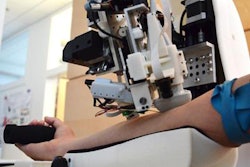Researchers from Vanderbilt University are developing an ultrasound helmet for the brain that could provide real-time images during surgery, define which areas of the brain get stimulated by certain feelings or actions, and even offer a way for people to control software and robotics by thinking about them.
Brett Byram, PhD, and colleagues are using a $550,000 grant from the U.S. National Science Foundation to develop machine learning that will integrate ultrasound with electroencephalogram (EEG) technology in the form of a helmet. The device will allow doctors to image brain perfusion as well as areas of stimulation related to movement and emotion.
"The goal is to create a brain-machine interface using an ultrasound helmet and EEG," Byram said in a statement released by the university. "Deep neural networks and machine learning have become popular, and our group is the first to show how you can use those for ultrasound beamforming."
Byram's group believes that applications of the technology could be wide-ranging. For example, a person with limited movement due to amyotrophic lateral sclerosis (ALS) could think about wanting a glass of water, and a robotic arm would retrieve it because the helmet detected blood flow and EEG information that told it to perform the task.



















